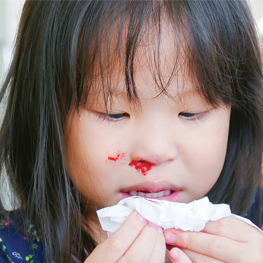
The nasal septum is the thin wall between the two nostrils. It has lots of sensitive blood vessels and can bleed very easily. A nosebleed happens when the septum is dry, picked at or injured. Nosebleeds in children are quite common and usually not serious.
What Causes a Nosebleed?
The most common causes of nosebleeds include:
Nose picking - Children tend to pick their noses when the air is dry and the mucous in their nose becomes crusty
Dry air – This is especially common in dry climates, or areas that use lots of indoor heating
Other, less common causes of nosebleeds include:
Injuries to the nose
Foreign object in the nose (ie: children putting small objects like beads in their nose)
Infections that cause lots of nose-blowing and forceful sneezing
Medications that dry out the nose, like
nose sprays
Medications that prevent blood clotting (ie: aspirin, blood thinners)
Irritants like cigarette smoke or chemical fumes
Nosebleeds usually occur suddenly either after any direct injury to the nose or while children are sleeping. While they can appear frightening, they are typically not painful and the bleeding is only from the front part of the nose. Sometimes children will swallow some blood that can irritate their stomach - if they vomit they may have a small amount of red/brown blood in their vomit. If your child has frequent nosebleeds and symptoms like easy bruising, gum bleeding, looking pale or being more tired than usual they should be seen by a doctor.
How can you help your child if they have a nosebleed?
At Home
When a child has a nosebleed it often looks like a lot of blood, but most nosebleeds are not life threatening. You can easily treat most nosebleeds at home by following these steps:
Stay calm - This will help keep your child calm as well.
Have your child sit upright in a chair or in your lap.
Help your child lean forward – this prevents blood from going down their throat. Swallowed blood can irritate the stomach and cause vomiting.
Using your thumb and index finger, squeeze firmly along the soft part of the nose just below the bony ridge.
Keep constant pressure for at least 20 minutes without interruption. If you take away the pressure too soon, the nose may start to
bleed again.
After 20 minutes, check for bleeding. If it is still bleeding, apply pressure for another 10 minutes.
Once the nosebleed has stopped, have your child play quietly and make sure they do not pick or rub their nose for the next few hours.
In Hospital
If your child’s nosebleed lasts more than 20 to 30 minutes, they should see a doctor. The doctor can look for where the bleeding is coming from. Doctors can perform nasal packing to help manage the nosebleed. Nasal packing is where gauze-like material is put in the nose to help put pressure on the blood vessels and control the bleeding. Packing is usually left in place for 24 to 48 hours and removed by a doctor.
If your child has repeated nosebleeds, they may be referred to an ENT (Ear Nose and Throat) specialist to look in their nose and recommend different treatments to help control the problem.
How Can I Prevent Nosebleeds?
Keep your child’s nails short to prevent nose picking.
Try to increase the humidity in your home, or get a cool-mist humidifier for your child’s room.
Add some moisture to your child's nose by using an over the counter nasal lubricant.
After a nosebleed, encourage your child to do quieter activities for one to two days. They should avoid lifting, straining or high intensity exercise/sports.
Limit medications like nasal sprays.
The content provided in this article is not intended to replace medical advice. If you have concerns about the health of your child, contact your health care provider directly. If your child has an emergency, go to the nearest emergency department or call 911.
HEAL is a resource aimed at providing families across Alberta easily accessible, reliable information about common minor illness and injuries in children. Alberta Health Services and Project HEAL strive to ensure that all material is correct but will not be held liable for errors or incomplete information contained in this article. Reprinted with permission by HEAL. For more information, visit albertahealthservices.ca/info/page12422.aspx.
Calgary’s Child Magazine © 2024 Calgary’s Child